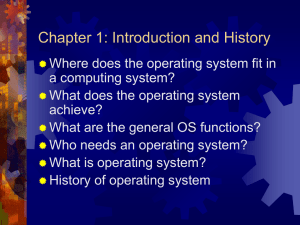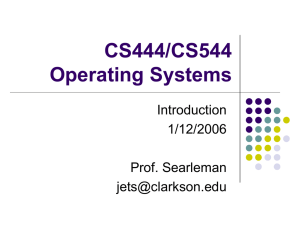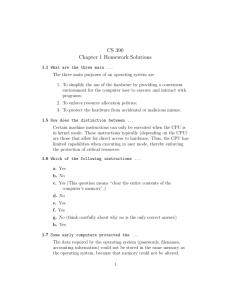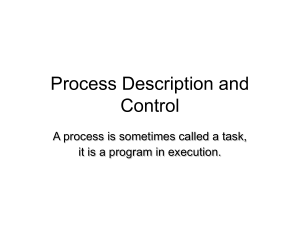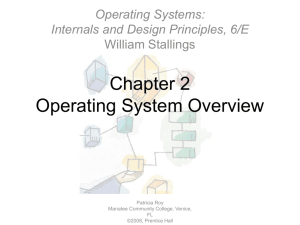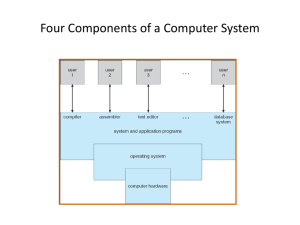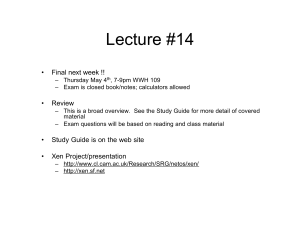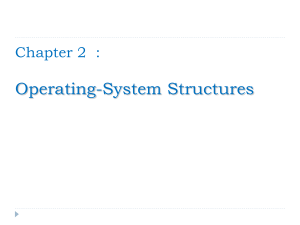os_ch1-2008
advertisement
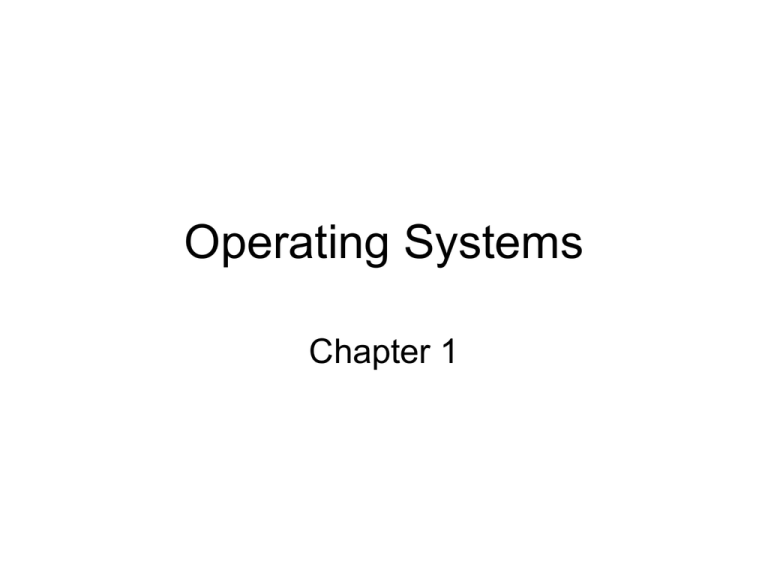
Operating Systems Chapter 1 Chapter outline 1 Introduction 1.1 What Operating Systems Do 1.4 Operating System Structure 1.5 Operating System Operations 1.6 Process Management 1.7 Memory Management 1.8 Storage Management 1.8.1, 1.8.2, 1.8.4 1.9 Protection and Security 1.11 Special-Purpose Systems Objectives • what an operating system is. • core operating system components. • core operating system operations. Take a moment to Contemplate! Computing Devices Everywhere Computing Devices Everywhere • Operating Systems drive the inner workings of virtually every computer in the world today • PCs, servers, iPods, cell phones, missile guidance systems, etc. all have an OS that dictate how they operate. • The OS manages many aspects of how programs run, and how they interact with hardware and the outside world. 1.1 What Operating System do? What Operating Systems DO? • The computer system can be divided roughly into four components: 1.The hardware 2.The operating system 3.The application software 4.The Users What Operating Systems DO? What does an Operating System do? • Silberschatz and Gavin: “An OS is Similar to a government” • Coordinator and Traffic Cop (i.e. Control Program): – Manages all resources – Settles conflicting requests for resources – Prevent errors and improper use of the computer • Facilitator (i.e. Resource Allocator): – Provides facilities that everyone needs – Standard Libraries, Windowing systems – Make application programming easier, faster, less error-prone • Some features reflect both tasks: – e.g. File system is needed by everyone (Facilitator) – But File system must be Protected (Traffic Cop) What is an Operating System,… Really? • Most Likely: – – – – Memory Management I/O Management CPU Scheduling Communications? (Does Email belong in OS?) • What about? – – – – File System? Multimedia Support? User Interface? Internet Browser? Operating System Definition • No universally accepted definition • “Everything a vendor ships when you order an operating system” is good approximation – But varies wildly • “The one program running at all times on the computer” is the kernel. – Everything else is either a system program (ships with the operating system) or an application program What if we didn’t have an OS? • Source CodeCompilerObject CodeHardware • How do you get object code onto the hardware? • How do you print out the answer? • Once upon a time, had to Toggle in program in binary and read out answer from LED’s! Altair 8080 1.4 Operating System Structure Operating System Structure • Multiprogramming needed for efficiency – Single user cannot keep CPU and I/O devices busy at all times – Multiprogramming organizes jobs (code and data) so CPU always has one to execute – A subset of total jobs in system is kept in memory – One job selected and run via job scheduling – When it has to wait (for I/O for example), OS switches to another job Memory Layout for Multiprogrammed System Operating System Structure • Timesharing (multitasking) is logical extension in which CPU switches jobs so frequently that users can interact with each job while it is running, creating interactive computing – Response time should be < 1 second – Each user has at least one program executing in memory process – If several jobs ready to run at the same time CPU scheduling – If processes don’t fit in memory, swapping moves them in and out to run – Virtual memory allows execution of processes not completely in memory 1.5 Operating-System Operations Operating-System Operations • Interrupt driven by hardware • Software error or request creates exception or trap – Division by zero, request for operating system service – Other process problems include infinite loop, processes modifying each other or the operating system Dual Mode Operation • Hardware provides at least two modes: – “Kernel” mode (or “supervisor” or “protected”) – “User” mode: Normal programs executed • Some instructions/ops prohibited in user mode: – Example: cannot modify page tables in user mode • Attempt to modify Exception generated • Transitions from user mode to kernel mode: – System Calls, Interrupts, Other exceptions Dual Mode Operation (2) • Operating system runs in Kernel mode and user programs run in User mode • Kernel Mode – Full access to machine instruction set – Direct access to hardware, memory, and input/output devices – OS and device drivers must run in Kernel mode • User Mode – Access to a limited set of machine instructions – No direct access to hardware, memory and input/output devices • Device access is coordinated by OS (must be privileged) Process Management (1) • A process is a program in execution. It is a unit of work within the system. Program is a passive entity, process is an active entity. • Process needs resources to accomplish its task – CPU, memory, I/O, files – Initialization data • Process termination requires reclaim of any reusable resources Process Management (2) • Single-threaded process has one program counter specifying location of next instruction to execute – Process executes instructions sequentially, one at a time, until completion • Multi-threaded process has one program counter per thread • Typically system has many processes, some user, some operating system running concurrently on one or more CPUs – Concurrency by multiplexing the CPUs among the processes / threads Process Management Activities The operating system is responsible for the following activities in connection with process management: • Creating and deleting both user and system processes • Suspending and resuming processes • Providing mechanisms for process synchronization • Providing mechanisms for process communication • Providing mechanisms for deadlock handling Memory Management (1) • All data in memory before and after processing • All instructions in memory in order to execute • Memory management determines what is in memory when – Optimizing CPU utilization and computer response to users Memory Management (2) • Memory management activities – Keeping track of which parts of memory are currently being used and by whom – Deciding which processes (or parts thereof) and data to move into and out of memory – Allocating and deallocating memory space as needed Storage Management (1) • OS provides uniform, logical view of information storage – Abstracts physical properties to logical storage unit - file – Each medium is controlled by device (i.e., disk drive, tape drive) • Varying properties include access speed, capacity, data-transfer rate, access method (sequential or random) Storage Management (2) • File-System management – Files usually organized into directories – Access control on most systems to determine who can access what – OS activities include • • • • Creating and deleting files and directories Primitives to manipulate files and dirs Mapping files onto secondary storage Backup files onto stable (non-volatile) storage media Mass-Storage Management (1) • Usually disks used to store data that does not fit in main memory or data that must be kept for a “long” period of time. • Proper management is of central importance • Entire speed of computer operation hinges on disk subsystem and its algorithms Mass-Storage Management (2) • OS activities – Free-space management – Storage allocation – Disk scheduling • Some storage need not be fast – Tertiary storage includes optical storage, magnetic tape – Still must be managed – Varies between WORM (write-once, read-manytimes) and RW (read-write) I/O Subsystem • One purpose of OS is to hide peculiarities of hardware devices from the user • I/O subsystem responsible for – Memory management of I/O including buffering (storing data temporarily while it is being transferred), caching (storing parts of data in faster storage for performance), spooling (the overlapping of output of one job with input of other jobs) – General device-driver interface – Drivers for specific hardware devices Protection and Security (1) • Protection – any mechanism for controlling access of processes or users to resources defined by the OS • Security – defense of the system against internal and external attacks – Huge range, including denial-of-service, worms, viruses, identity theft, theft of service Protection and Security (2) • Systems generally first distinguish among users, to determine who can do what – User identities (user IDs, security IDs) include name and associated number, one per user – User ID then associated with all files, processes of that user to determine access control – Group identifier (group ID) allows set of users to be defined and controls managed, then also associated with each process, file – Privilege escalation allows user to change to effective ID with more rights OS Operations a snapshot User Application User Application User Application Protection Boundary Kernel Memory Management File System Device Drivers CPU Scheduling Disk I/O Process Mang. Multitasking Networking Hardware/ Software interface Hardware 1.11 Special-Purpose Systems Special-Purpose OS • Real-Time – Useful for special-purpose applications, typically managing custom hardware – Generally work in an environment with fixed timeconstraints – Interrupt Driven (more on this later) • Embedded – Special purpose systems • Cell phones, wireless routers, TV’s, space vehicles, etc. – Requirements • High reliability, difficult or impossible to upgrade after deployed, run in hostile environments, self-diagnosis and repair, unattended operation. Special-Purpose OS (2) • Multimedia systems – Online radio • Handheld systems – – – – Physical Memory Speed I/O Examples • • • • Windows Mobile Palm Linux Symbian Chapter Conclusion Conclusion • Operating systems provide a virtual machine abstraction to handle diverse hardware • Operating systems coordinate resources and protect users from each other • Operating systems simplify application development by providing standard services References • Pictures & some slides – Prof. Kubiatowicz & Prof. Anthony, Berkeley university, Prof. Welsh, Harvard University – OS slides by A. Detiel et. al • Content – Text book – Modern OS Book – Wikipedia • http://en.wikipedia.org/wiki/History_of_the_Linux_kernel • http://en.wikipedia.org/wiki/Operating_system • And much more
